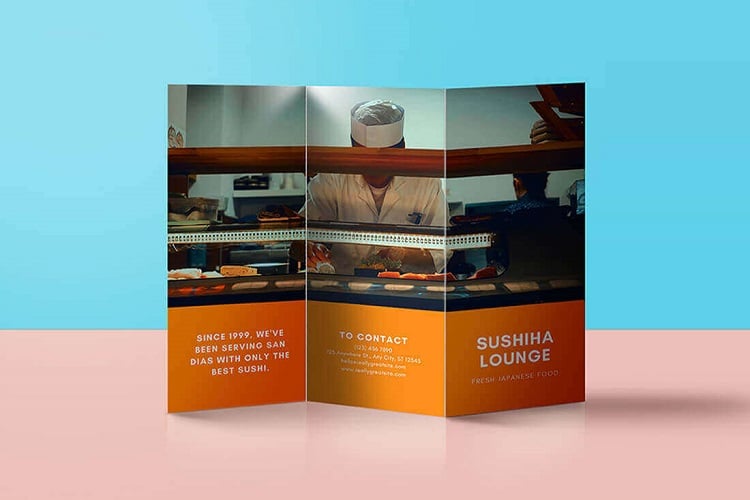Pamphlet vs Brochure: What’s The Difference?
Chances are you’ve used the terms “pamphlet” and “brochure” interchangeably. Maybe you’ve even done this when it came to the promotion of your products or services.
But aren’t pamphlets and brochures the same thing? Although they look very similar, pamphlets and brochures have some important differences that you should know about.
With that in mind, let’s explore the pamphlet vs brochure debate. Here’s what you should know so you can choose the one to meet your needs most effectively.
What Is A Pamphlet?

A pamphlet is a small, unbound booklet that is used to provide people with information on a topic or to advertise products or services.
Sometimes, a pamphlet is called a leaflet. What can make it confusing is that sometimes people call a pamphlet a booklet, but these are different terms.
A booklet is always bound with staples or other accessories, as it contains multiple pages. A pamphlet, on the other hand, is within the category of booklets, but it’s typically unbound.
Purpose
A pamphlet is primarily used to inform people about a specific topic. It’s not used for direct selling. Common uses of pamphlets include event promotion, company information, and political campaigns.
A pamphlet is focused on providing information in a clear, concise way to make it easy to understand. A pamphlet can also announce a social event to build awareness of, and interest in, it.
Design
Pamphlets can come in a variety of sizes and shapes, and they can vary when it comes to how many pages they have. That said, they are thin and won’t have too many pages in them. They’re not meant to be a booklet, as we mentioned earlier.
When it comes to the paper that’s used to make a pamphlet, an ordinary paper that’s not glossy is the standard choice. This makes pamphlets a cost-effective option.
Types
There are three common types of pamphlets:
- Civic pamphlets. These pamphlets are used to provide information about local issues, such as upcoming elections.
- Cultural pamphlets. These pamphlets provide information about cultures and countries, such as demographic data.
- Educational pamphlets. These are ideal when you want to give people information about a specific topic, such as in the medical, scientific, or technology fields.
Style
Pamphlets are designed to be easy on the eye. Their text steers clear of complex ideas or jargon that can confuse readers or make it difficult for them to grasp the purpose of the pamphlet’s message.
When designing a pamphlet, it has to be written for the man on the street. It has to be simple. Images and text that are featured in the pamphlet need to be organized in such a way that they are clear and in line with the main message.
What Is A Brochure?

A brochure is a promotional material that takes the form of folded paper, and sometimes it can be called a booklet. Instead of covering just one topic in them, brochures can cover a variety of subjects.
Purpose
Brochures are mainly used to advertise services or products for a company. You’ll find that brochures generally contain more images than words.
They’re great for introducing a new product to the public and providing details about it.
Brochures can also be used to provide information about what a company is about and what services/products it offers to customers.
Design
A brochure can have a single page or many pages that are folded several times. This produces separate pages of text and images.
Alternatively, a brochure can take the form of several pages stapled together. A brochure can be bound, but this is not always necessary.
Since a brochure typically contains many images, it’s printed on glossy paper. This elevates its overall appearance and makes it more attractive to people.
Types
There are quite a few types of brochures, depending on how they’re folded. Here are three common types of brochures.
- Bi-fold brochure: This is a brochure that folds up into four panels, all of which are large. The panels contain images and information. This brochure is used for informational purposes because of its larger space that can be dedicated to more content. You should choose a bi-fold brochure when you want to reach people via hand delivery or at retail stores.
- Trifold brochure: By comparison, this type of brochure has two folds. It contains six panels on it. A trifold brochure usually has a thinner outline than a bi-fold brochure. It’s designed primarily for distribution by hand or mail. It’s also small enough to be stacked on shelves of retail stores while being convenient to carry around by hand.
- Z-fold brochure: Z-fold brochures are ideal for when the brochure’s design is spread across three panels on the same side. The page opens easily so that you can view the content when you’re holding the first and third panel of the brochure.
Style
While a brochure should be written in a clear, concise way, it does tend to go deeper into information and can tackle more than one topic simultaneously as compared to a pamphlet.
Therefore, it can be a bit more in-depth than a pamphlet. It also makes use of lots of images.
Pamphlet vs Brochures: Similarities and Differences

From what we’ve already featured in this article, it’s clear to see that pamphlets and brochures have a few similarities. They’re both printed on paper, and they’re meant to be small and convenient so that they’re easy to carry.
They have some other important differences to know about, though. Let’s take a look at them in different categories.
Price
A brochure is usually more expensive than a pamphlet. This is because of how it’s printed on glossy paper. The use of quality designs and images can also bump up the cost of brochures.
As for pamphlets, they’re more affordable than brochures. They don’t cost as much to print because of how they don’t require special or glossy paper.
Folds
As we mentioned earlier, brochures can be folded once or multiple times. By comparison, a pamphlet can be folded but it’s usually printed on a single paper so it’s more straightforward.
Attractiveness
A brochure is designed to be as eye-catching as possible, hence its glossy paper and high-quality images.
By comparison, although a pamphlet can look good, it’s focused on providing information instead of being glossy or full of images.
Size
A brochure is usually larger in size than a pamphlet. This makes sense because it usually tackles more than one topic or it can provide extensive information on a topic.
A pamphlet is more concise, targeting a specific subject, so it requires less space for its content.
How To Design A Good Pamphlet Or Brochure

While they’re quite different, there are important tips to bear in mind when designing a pamphlet or brochure to ensure your message reaches the public effectively. Here are some to know about.
- Focus on your goals: Are you trying to educate members of the public about a specific topic? If so, you should design a pamphlet. On the other hand, are you trying to inform people about a new line of skincare products? Send out brochures instead.
- Use simple fonts: You want your pamphlet or brochure to be as memorable as possible, but don’t choose fonts or other design features that are complicated or too graphic. These can be difficult to read while also distracting people from the information you want them to take away after reading the pamphlet or brochure. Focus on regular fonts, such as verdana, that are easy to read.
- Deliver high-quality images: This is especially important to bear in mind if you’re designing a brochure. You want your images to look professional and appealing. Always do a print test of your pamphlet or brochure before you send it out to prevent issues such as blurriness. That’s an instant turn-off for readers, as it can make the document look less professional.
- Put yourself in the reader’s shoes: Make sure your copy is accessible and easy to understand. Try to avoid using jargon that not everyone will understand.
You should also separate text so that you don’t have a large block of words on the page. This can make it feel difficult for the reader to get through.
Tips On How To Distribute Pamphlets And Brochures

If you’ve designed pamphlets or brochures, and you’re ready to distribute them to your target audience, you’ll need to follow some important tips.
- It’s important to know who you’re targeting and where they work and hang out. This will enable you to know where to place your pamphlets or brochures. It’s also good to pay attention to any events that are being held in the area where you wish to target people, as these can be useful places for you to send out your material.
- Distribute the material at the right time and place. If your pamphlet is medical-related, for example, it’s a good idea to distribute it at clinics, doctor’s rooms, dentist rooms, hospitals, and so on. People who are attending those places will be more likely to be interested in the material you’re trying to send out.
- It’s also smart to provide reading material to people when they’re waiting for something, such as in a doctor’s room or in a queue, as it gives them something to do.
- A good location where you should distribute your pamphlet is at trade shows or other events related to the information your pamphlet contains. If you have designed a woodworking brochure, for instance, you should distribute it to people at woodworking trade shows. You’ll be bringing the information to people who are more likely to be receptive to it.
- Don’t forget about digital distribution. You might prefer physical distribution because you’re guaranteed of reaching your target audience, but technology enables you to reap the benefits of having digital versions of your material. These are more affordable and you can reach an infinite amount of people online with them. You can also combine your material with other promotional materials, such as on social media, for increased effectiveness. Whether you’re using physical and/or digital distribution, make use of QR codes to increase their effectiveness as they will direct your customers to media and information you want them to see. You can find out more about this by reading, “How To Add A QR Code To A Flyer.”
Related Questions
What is a flyer?

A flyer is quite similar to a poster. It’s printed on one side to promote an event and it gets handed out to people. A flyer is designed to be easy to read, with large text and images.
What is a rack?
A rack is a small document that’s designed to promote and advertise products or services. It’s usually placed inside racks with other rack cards so people passing by can pick them up.
You’ll find these rack cards in places like convenience stores and hotels.
Conclusion
If you need to choose between a pamphlet and a brochure, you need to know how they differ so you can choose the best one for your purposes. Although they seem to be the same thing, they’re actually quite different.
In this article, we’ve featured the similarities and differences between them that you need to know.
Pamphlet vs brochure: which one should you use? Generally, if you need to promote products or services, you will want to choose a brochure.
By comparison, if you want to provide the public with information about a specific topic, choosing a pamphlet makes more sense to get your message across in the most effective way.
